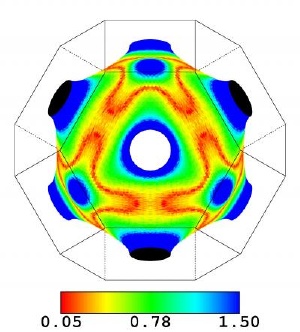Feb 27 2009
Just as sonar sends out sound waves to explore the hidden depths of the ocean, electrons can be used by scanning tunnelling microscopes to investigate the well-hidden properties of the atomic lattice of metals. As researchers from Göttingen, Halle and Jülich now report in the high-impact journal "Science", they succeeded in making bulk Fermi surfaces visible in this manner. Fermi surfaces determine the most important properties of metals.
 This is the Fermi surface around a cobalt atom embedded in copper. The colors represent the curvature of the surface, which determines the reflection properties for electron waves. Credit: Forschungszentrum Jülich
This is the Fermi surface around a cobalt atom embedded in copper. The colors represent the curvature of the surface, which determines the reflection properties for electron waves. Credit: Forschungszentrum Jülich
"Fermi surfaces give metals their personality, so to speak," explained Prof. Stefan Blügel, Director at the Jülich Institute of Solid State Research. Important properties, such as conductivity, heat capacity and magnetism, are determined by them. On the Fermi surfaces inside the atomic union, high-energy electrons are in motion. Depending on what form the surfaces have and what mobility is assigned to the electrons, they determine the physical properties of metals.
In their latest publication, the researchers report on how they used a scanning tunnelling microscope to direct electrons into a copper sample. As electrons spread out like waves, they pass through the metal and are scattered and reflected at obstacles in the bulk, such as single cobalt atoms. "The overlap between incoming and outgoing waves is so strong," said Dr. Samir Lounis from Forschungszentrum Jülich who turned the theoretical calculations into an experiment, "that they can be measured as spherical patterns on the surface using the scanning tunnelling
The somewhat deformed rings on the surface allow us to draw direct conclusions on the shape of the Fermi surfaces and the depth of the cobalt atoms, similar to how sonar recognises the ocean floor by means of reflected sound waves. "We hope that more sophisticated methods will make it possible to gain a detailed understanding of deep impurities and interfaces between atomic lattices," explained Lounis. For his simulations of the scanning tunnelling experiment, he used the supercomputer known as JUMP in the Jülich Supercomputing Centre.
In a related article in the "Perspectives" section of "Science", the innovative approach is praised. A scanning tunnelling microscope is primarily used to characterise the surface of a sample. Thanks to the theoretical work in Jülich, it can now be used to gain a direct insight into the bulk of solids and to understand interesting effects in the nanoworld.